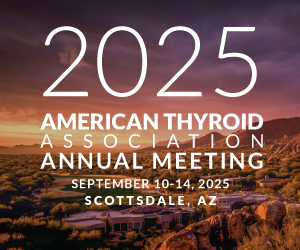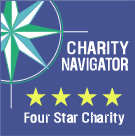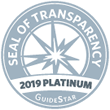 Presented by Gregory A. Brent, MD
Presented by Gregory A. Brent, MD
American Thyroid Association
Annual Business Meeting
Renaissance Esmeralda Resort & Spa
Indian Wells, California
Thursday, October 27, 2011
Thanks, Rick. I’ve been counseled that the briefer I am, the better for everyone, although I would like to reflect just a bit, and hopefully you’ll allow me a few minutes. It’s been a wonderful year. It’s certainly great to be surrounded by friends, here, in such a beautiful setting.
I have had the privilege of serving as president the past year and will share a few highlights of my experience. It is impossible to list all of the programs and people that have contributed to the outstanding success we have experienced in the past year, Rick Kloos has not only done a superb job as Secretary/COO, but in the current issue of Signal has beautifully summarized the accomplishments of the ATA during his term. I encourage all members to read through this to appreciate all that has occurred.
I am grateful to Terry Davies, who provided a smooth transition and encouraged me to pursue our goals of mutual interest during my time as president. I will try to highlight several domains that illustrate the way that the ATA touches a very wide range people, and the impact that it has had on me.
Representing the ATA internationally was a high point of my year. One of these trips was directly on ATA business, to go with Rick Kloos and represent the ATA at the WTF meeting held in conjunction with the ETA meeting in Poland in September. It was a great experience in Krakow Poland spending time with many colleagues in the ETA, and ATA colleagues that made the trip. I took 3 other trips as President-Elect or President to Korea, China, and Istanbul Turkey, not supported by the ATA, but as a guest. These trips included talks at national endocrine or thyroid meetings, and the chance to interact with thyroid leaders in these 3 countries. Many of you have taken similar trips, but I felt a special honor and responsibility representing the ATA. In Istanbul, Turkey, the program at Achibadem University, included current and past ETA presidents, Peter Laurberg and Wilmar Wiersinga, the trip to China was with ETA colleagues Victor Popp and Bernadette Biondi. Whether I was in Korea, China, or Turkey, every academician I met was proud to tell me of the laboratory in Europe or the US that they had trained. Despite the significant scientific progress in all these countries, especially Korea, the connection to mentors in the US and Europe remains a key to career development. Korea and China have very large thyroid associations of their own. These groups have upwards of 500 members, have their own meetings, and like the ATA, are characterized by very close connections between endocrinologists and surgeons. They are adapting guidelines for their own countries, promoting research, and reaching out to educate primary care physicians. The value of impact of organizations is significant. How should the ATA partner and support these efforts, yet continue to foster ATA members and growth? We are a global organization in membership and among those that attend our meeting, and I believe we can identify strategic partnerships directly with these groups that can extend our reach.
We have made progress in our goal to reach out and partner with other societies. We developed a partnership with the Society of Nuclear Medicine on patient programs through a meeting I attended here in Palm Springs last winter, as well as our continued partnership with AACE and Endocrine Society, especially for rapid response to issues, such as radiation exposure from the Japanese nuclear accident. Bobbi, Rick and I represented the ATA at the Endocrine Sister Societies, hosted this year by the Endocrine Society. We have operated under what I would term a hybrid guideline policy, primarily producing our own guidelines and then asking for endorsements, but have embarked on some partnership with joint guideline projects. We have had executive leadership in the past, that promoted or supported joint guidelines, including in one case, myself. Although there are a number of excellent reasons for such partnerships, it is rarely, if ever an equal enterprise. In the majority of our guidelines, which we initiate and control, we invite participants across disciplines, societies, and in most cases international representation, to be sure that there is the greatest impact. The success of this approach is reflected in the incredible impact our guidelines have had. The practice of asking for endorsements after guideline preparation, although practiced by The Endocrine Society and others, engenders significant criticism, often by those groups closest to us, including thyroid sister societies. Do we need partners to increase the impact or visibility of our guidelines? This this does not seem to be the case as we have repeatedly shown. This will continue to be a source of discourse and discussion, but our recent history shows the strong benefits we have reaped in developing our own guidelines.
The surgical task force has transitioned to committee status this year, co-chaired by Ralph Tufano and now Barry Inabnet, selected to replace Gerry Doherty who was elected to a position on the Board. The surgical affairs committee has identified and implemented programs that have been highly successful in engaging our surgeon members. This year we have looked at surgeon representation across the committees to continue to grow this segment of our membership. We have, in some cases, worked to have representation that will stimulate membership by groups not currently represented in large numbers. An example is representation by pathologists. Terry Davies initiated a pathology task force led by Sylvia Asa that made recommendations we have implemented to encourage pathologist members. Examples of other groups we would like to increase participation from are basic scientists, pediatric endocrinologists, nuclear medicine physicians, and medical oncologists. These discussions have also causes the board to revisit issues of designated positions within the board of directors for specific constituencies, which will be part of a proposed bylaw change we will vote on tonight. I support such an approach and look forward to how this will be implemented. We also continue to target representation by younger and newer members. In order to continue to grow the ATA needs to engage all medical and scientific disciplines with an interest in the thyroid and thyroid diseases.
Our publications have a major impact on the outreach and stature of our organization. Charles Emerson has done an outstanding job as Editor of Thyroid. Building on the foundation of the founding editor, Jerry Hershman and then Terry Davies, Charles has taken Thyroid to its highest impact factor ever, 4.3. This puts our journal in the top tier of endocrine journals. Such an impact factor is a major stimulus for submission of manuscripts, especially from Europe and Asia where the impact factor of published articles is directly used in calculations for academic promotion. Jerry Hershman took over Clinical Thyroidology, our digest publication, from the outstanding leadership of Ernie Mazzaferri, and with his associate Editors has done an outstanding job. Alan Farwell and his colleagues then modify these articles to produce the very popular Clinical Thyroidology for Patients. Peter Kopp has done an outstanding job in providing leadership to the publications committee during a very active time period. He completed a survey to assess member attitudes about our publications, which he is using, as well as taking a careful look at the management of our publication portfolio, which will be a topic of our winter board retreat.
I was able to represent the ATA at fellows programs at meeting of APDEM at the Endo Soc meetings in San Diego and in Boston. We can be proud of the wide range of services that we offer fellows: our fellow’s corner on the web, our offers of free associate membership, and Thyroid subscriptions. Susan Mandel, and ATA member and APDEM president, challenged the other sister societies to step up. The growth in membership and diversity of our association and success of our annual meeting is the result of the passion of our members who have faithfully supported and contributed their money, time and energy to our association for 20, 30 and for a significant number of members, more than 50 years. It is those mentors who have forever touched our personal and professional lives by investing in our training and passing on their passion for science and clinical medicine. It is a direct result of the efforts many members have made to reach out and invite colleagues to join and become engaged in the work of the ATA.
Stimulation of Basic Science in the ATA remains challenging. Tony Bianco and his colleagues have a draft of a report from a group begun by Terry Davies, Strategies and Methods for Research on Thyroid Hormone Homeostasis, Metabolism and Action. Jim has appointed an outstanding basic science chair, research, partnering with Gordon Conferences, NIH, and Thyroid Resistance.
Steve Sherman launched the ATA Corporate Leadership Council, which is moving forward under the guidance of current development chair Greg Randolph and his committee. A measure of the health of an association, however, is the commitment of its members to providing financial support. For many of us, whether introduced to the ATA by a colleague or mentor, the association has been our primary professional home and has served as a foundation that has launched our professional paths. Opportunities to provide financial support to the ATA are many and varied and include contributing to research, special recognition funds, or–the most flexible option–to our general operations. The most direct way to ensure that others can enjoy the same opportunities in the future is to preserve and strengthen the ATA through monetary gifts.
My most recent time representing the ATA was at the Thyroid Cancer Survivor Association (ThyCa’s) annual meeting for patients in Los Angeles, where I led a workshop. What a privilege to be with Gary Bloom and his colleagues for a conference with over 500 patients. I was moved by the stories patients told, their families that came with them, the father I spoke with there on behalf of his daughter, now 15, operated on at age 12 for papillary thyroid cancer, the recently diagnosed woman now with lung metastases. ThyCa has raised almost $700,000 in research funds, which the ATA has distributed through the work of our research committee. I shared with them the impact that their contributions have made. ThyCa is a Spartan meeting, with water as the only refreshment on site and Gary copying material and stuffing envelopes. Gary told me that they happily conduct their meetings in this way, so they can direct all the money they receive to support research. My own mother had died from metastatic breast cancer just a few days earlier, and it was fitting that I was with this group of patients. I was deeply moved by these patients suffering from advanced thyroid cancers and their loved ones, and their dedication to support research.
I am humbled by the dedication of our board and officers, by the selfless work that committee chairs and members perform. I will be passing the presidential gavel into the capable hands of Dr. Jim Fagin at the close of the annual meeting, as Terry Davies passed the gavel to me last year. Jim has been fully engaged in the work of the ATA board and executive committee as president-elect this past year, and has already been making his committee appointments and developing initiatives for the coming year. Dr. Rick Kloos will be completing his term as Secretary/Chief Operating Officer this year. Rick has provided outstanding leadership to the ATA, guiding our association through a very challenging time and leaving us stronger than ever. I hope that every member will take the time to personally thank Rick for his contributions and dedication in this position that has become more complex and demanding as our association has grown. The personal and professional sacrifices necessary to do the job in the way that Rick has done it are beyond what anyone knows. Dr. John Morris brings a long record of service to the ATA and outstanding leadership skills as our incoming Secretary/Chief Operating Officer and I know will do an exceptional job. Finally, our ATA staff, under the leadership of Bobbi Smith, continues to provide outstanding administrative support to our ever expanding programs. Bobbi has nurtured a nimble staff, cross-trained in several roles, and strategic use of consultants, to leverage our modest-sized administrative team to accomplish a large amount of work. Despite the complexity of our organization, our staff have maintained the warm and personal touch that make each member feel valued and important, and you are.
What are the issues of the future? Our financial support and industry relations are central, how can we continue to improve income stream in ways that are acceptable to members? We need to continue to foster and grow our younger members, engaging them in the work of the ATA and identifying and meeting their needs. We need to maintain our diversity of disciplines, a core reason for our strength, without deviating too much from our base. How do we leverage our position as the recognized world’s leading thyroid association?






